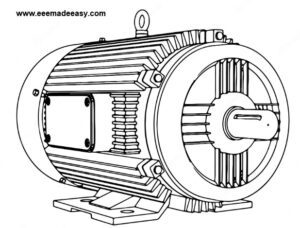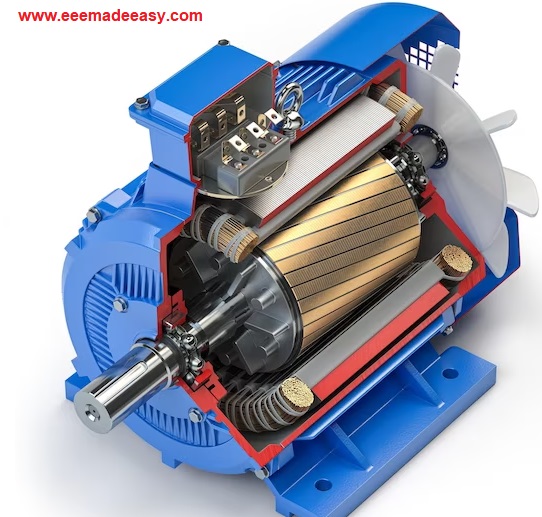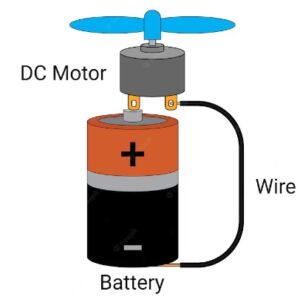Electrical Machines MCQ Questions and answers
MCQ questions on DC Motor: Here , You can find Electrical Machines Objective questions and answers which will be useful for Competitive Exams and University Exams.
- No-load speed of which of the following motor will be highest ?
(a) Shunt motor
(b) Series motor
(c) Cumulative compound motor
(d) Differentiate compound motor
Ans: b - The direction of rotation of a D.C. series motor can be changed by
(a) interchanging supply terminals
(b) interchanging field terminals
(c) either of (a) and (b) above
(d) None of the above
Ans: b - Which of the following application requires high starting torque ?
(a) Lathe machine
(b) Centrifugal pump
(c) Locomotive
(d) Air blower
Ans: c - If a D.C. motor is to be selected for conveyors, which rriotor would be preferred ?
(a) Series motor
(b) Shunt motor
(c) Differentially compound motor
(d) Cumulative compound motor
Ans: a - Which D.C. motor will be preferred for machine tools ?
(a) Series motor
(b) Shunt motor
(c) Cumulative compound motor
(d) Differential compound motor
Ans: b
Read : MCQs on DC Motor Tests|Tests on DC Motor Objective Questions

- Differentially compound D.C. motors can find applications requiring
(a) high starting torque
(b) low starting torque
(c) variable speed
(d) frequent on-off cycles
Ans: b - Which D.C. motor is preferred for elevators ?
(a) Shunt motor
(b) Series motor
(c) Differential compound motor
(d) Cumulative compound motor
Ans: d - According to Fleming’s left-hand rule, when the forefinger points in the direction of the
field or flux, the middle finger will point in the direction of
(a) current in the conductor aovtaat of conductor
(c) resultant force on conductor
(d) none of the above
Ans: a - If the field of a D.C. shunt motor gets opened while motor is running
(a) the speed of motor will be reduced %
(b) the armature current will reduce
(c) the motor will attain dangerously high speed 1
(d) the motor will continue to nuvat constant speed
Ans: c - Starters are used with D.C. motors because
(a) these motors have high starting torque
(b) these motors are not self-starting
(c) back e.m.f. of these motors is zero initially
(d) to restrict armature current as there is no back e.m.f. while starting
Ans: d - In D.C. shunt motors as load is reduced
(a) the speed will increase abruptly
(b) the speed will increase in proportion to reduction in load
(c) the speed will remain almost/constant
(d) the speed will reduce
Ans: c
Read : Speed Control of D.C Motor MCQ Questions|Objective Questions on DC Motor Speed Control

- A D.C. series motor is that which
(a) has its field winding consisting of thick wire and less turns
(b) has a poor torque
(c) can be started easily without load
(d) has almost constant speed
Ans: a - For starting a D.C. motor a starter is required because
(a) it limits the speed of the motor
(b) it limits the starting current to a safe value
(c) it starts the motor
(d) none of the above
Ans: b - The type of D.C. motor used for shears and punches is
(a) shunt motor
(b) series motor
(c) differential compoutid D.C. motor
(d) cumulative compound D.C. motor
Ans: d - If a D.C. motor is connected across the A.C. supply it will
(a) run at normal speed
(b) not run
(c) run at lower speed
(d) burn due to heat produced in the field winding by .eddy currents
Ans: d - To get the speed of D.C, motor below the normal without wastage of electrical energy
is used.
(a) Ward Leonard control
(b) rheostatic control
(c) any of the above method
(d) none of the above method
Ans: a - When two D.C. series motors are connected in parallel, the resultant speed is
(a) more than the normal speed
(b) loss than the normal speed
(c) normal speed
(d) zero
Ans: c
Read : FHP Motor| Fractional Horse Power Motor
- The speed of a D.C. shunt motor more than its full-load speed can be obtained by
(a) decreasing the field current
(b) increasing the field current
(c) decreasing the armature current
(d) increasing the armature current
Ans: a - In a D.C. shunt motor, speed is
(a) independent of armature current
(b) directly proportional to the armature current
(c) proportional to the square of the current
(d) inversely proportional to the armature current
Ans: a - A direct on line starter is used: for starting motors
(a) iip to 5 H.P.
(b) up to 10 H.P.
(c) up to 15 H.P.
(d) up to 20 H.P.
Ans: a - What will happen if the back e.m.f. of a D.C. motor vanishes suddenly?
(a) The motor will stop
(b) The motor will continue to run
(c) The armature may burn
(d) The motor will run noisy
Ans: c - In case of D.C. shunt motors the speed is dependent on back e.m.f. only because
(a) back e.m.f. is equal to armature drop
(b) armature drop is negligible
(c) flux is proportional to armature current
(d) flux is practically constant in D:C. shunt motors
Ans: d - In a D.C. shunt motor, under the conditions of maximum power, the current in the
armature will be
(a) almost negligible
(b) rated full-load current
(c) less than full-load current
(d) more than full-load current
Ans: d

- These days D.C. motors are widely used in
(a) pumping sets
(b) air compressors
(c) electric traction
(d) machine shops
Ans: c - By looking at which part of the motor, it can be easily confirmed that a particular
motor is D.C. motor?
(a) Frame
(b) Shaft
(c) Commutator
(d) Stator
Ans: c - In which of the following applications D.C. series motor is invariably tried?
(a) Starter for a car
(b) Drive for a water pump
(c) Fan motor
(d) Motor operation in A.C. or D.C.
Ans: a - In D.C. machines fractional pitch winding is used
(a) to improve cooling
(b) to reduce copper losses
(c) to increase the generated e.m.f.
(d) to reduce the sparking
Ans: d - A three point starter is considered suitable for
(a) shunt motors
(b) shunt as well as compound motors
(c) shunt, compound and series motors
(d) all D.C. motors
Ans: b - In case-the conditions for maximum power for a D.C. motor are established, the
efficiency of the motor will be
(a) 100%
(b) around 90%
(c) anywhere between 75% and 90%
(d) less than 50%
Ans: d
- The ratio of starting torque to full-load torque is least in case of
(a) series motors
(b) shunt motors
(c) compound motors
(d) none of the above
Ans: b - In D.C. motor which of the following can sustain the maximum temperature rise?
(a) Slip rings
(b) Commutator
(c) Field winding
(d) Armature winding
Ans: c - Which of the following law/rule can he used to determine the direction of rotation of
D.C. motor ?
(a) Lenz’s law
(b) Faraday’s law
(c) Coloumb’s law
(d) Fleming’s left-hand rule
Ans: d - Which of the following load normally needs starting torque more than the rated
torque?
(a) Blowers
(b) Conveyors
(c) Air compressors
(d) Centrifugal pumps
Ans: b - The starting resistance of a D.C. motor is generally
(a) low
(b) around 500 Q
(c) 1000 Q
(d) infinitely large
Ans: a - The speed of a D.C. series motor is
(a) proportional to the armature current
(b) proportional to the square of the armature current
(c) proportional to field current
(d) inversely proportional to the armature current
Ans: d
- In a D.C. series motor, if the armature current is reduced by 50%, the torque of the
motor will be equal
to
(a) 100% of the previous value
(b) 50% of the previous value
(c) 25% of the previous value
(d) 10% of the previous value
(e) none of the above
Ans: c - The current drawn by the armature of D.C. motor is directly proportional to
(a) the torque required
(b) the speed of the motor
(c) the voltage across the terminals
(d) none of the above
Ans: a - The power mentioned on the name plate of an electric motor indicates
(a) the power drawn in kW
(b) the power drawn in kVA
(c) the gross power
(d) the output power available at the shaft
Ans: d - Which D.C. motor has got maximum self loading property?
(a) Series motor
(b) Shunt motor
(c) Cumulatively compounded ‘motor
(d) Differentially compounded motor
Ans: d - Which D.C. motor will be suitable alongwith flywheel for intermittent light and heavy
loads?
(a) Series motor
(b) Shunt motor
(c) Cumulatively compounded motor
(d) Differentially compounded motor
Ans: c
- If a D.C. shunt motor is working at no load and if shunt field circuit suddenly opens
(a) nothing will happen to th£ motor
(b) this will make armature to take heavy current, possibly burning it
(c) this will result in excessive speed, possibly destroying armature due to excessive
centrifugal stresses (d) motor will run at very slow speed
Ans: c - D.C. series motors are used
(a) where load is constant
(b) where load changes frequently
(c) where constant operating speed is needed
(d) in none of the above situations.
Ans: d - For the same H.P. rating and full load speed, following motor has poor starting torque
(a) shunt
(b) series
(c) differentially compounded
(d) cumulativelyc’ompounded
Ans: c - In case of conductively compensated D.C. series motors, the compensating winding is
provided
(a) as separately wound unit
(6) in parallel with armature winding
(c) in series with armature winding
(d) in parallel with field winding
Ans: c - Sparking at the commutator of a D.C. motor may result in
(a) damage to commutator segments
(b) damage to commutator insulation
(c) increased power consumption
(d) all of the above
Ans: d - Which of the following motor is preferred for operation in highly explosive
atmosphere ?
(a) Series motor
(b) Shunt motor
(c) Air motor
(d) Battery operated motor
Ans: c
Download & Install EEE Made Easy App
- If the supply voltage for a D.C. motor is increased, which of the following will decrease
?
a) Starting torque
(b) Operating speed
(c) Full-load current
(d) All of the above
Ans: c - Which one of the following is not the function of pole shoes in a D.C. machine ?
(a) To reduce eddy current loss
(b) To support the field coils
(c) To spread out flux for better unifor-mity
(d) To reduce the reluctance of the mag-netic path
Ans: a - The mechanical power developed by a shunt motor will be maximum when the ratio
of back e.m.f. to applied voltage is
(a) 4.0
(b) 2.0
(c) 1.0
(d) 0.5
Electrical Machines Best Books
| Sl no. | Book Title | Author | Buy Link |
|---|---|---|---|
| 1 | Textbook Of Electrical Technology : Ac And Dc Machines (volume – 2) | B L Theraja, AK Theraja | check price |
| 2 | Theory & Performance of Electrical Machines | J.B. Gupta | check price |
| 3 | Electrical Machines | by V.K Mehta, Rohit Mehta | check price |
| 4 | Electric Machines | PS Bimbhra | check price |
| 5 | Electrical Machines | S.K. Bhattacharya | check price |
Also READ similar posts Below
| Basic Electrical Engineering MCQ’s From Notebook Site (www.notebukofaprofessor.blogspot.com) |
| 1. Basic Electrical Engineering MCQ 1 |
| 2. Current Electricity MCQ |
| 3. Basic Electrical MCQ 2 |
| 4. Basic Electrical Engineering MCQ 3 |
| 5. Basic Electrical Engineering MCQ 4 |
| 6. Basic Electrical Engineering MCQ 5 |
| 7. Basic Electrical Engineering MCQ 6 |
| 8. Basic Electrical Engineering MCQ 7 |
| 9. Basic Electrical Engineering MCQ 8 |
| 10. Basic Electrical Engineering MCQ 9 |
| 11. Basic Electrical Engineering MCQ 10 |
| 12. Basic Electrical Engineering MCQ 11 |
| 13. Basic Electrical Engineering MCQ 2 |
| 14. Basic Electrical Engineering MCQ 14 |
- Industries Extension Officer Syllabus Kerala PSC|IEO 2024 Syllabus
- [PDF]Trade Instructor Gr.II Electroplating Syllabus Kerala PSC|92/2023 syllabus
- [PDF] Syllabus Assistant Engineer Electrical Harbour Engineering Kerala PSC
- Industries Extension Officer Kerala PSC Notification|IEO 2024
- Electricity Act 2003 Section 135
- Synchronous Motor Advantages, Disadvantages & Applications
- [Latest]Assistant Director industries and commerce Kerala PSC syllabus|630/2023 syllabus






